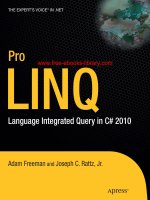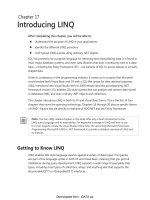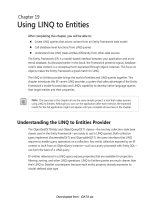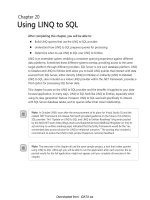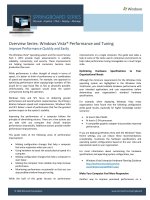linq quickly
Bạn đang xem bản rút gọn của tài liệu. Xem và tải ngay bản đầy đủ của tài liệu tại đây (6.82 MB, 250 trang )
www.it-ebooks.info
LINQ Quickly
A practical guide to programming Language
Integrated Query with C#
N Satheesh Kumar
BIRMINGHAM - MUMBAI
www.it-ebooks.info
LINQ Quickly
Copyright © 2007 Packt Publishing
All rights reserved. No part of this book may be reproduced, stored in a retrieval
system, or transmitted in any form or by any means, without the prior written
permission of the publisher, except in the case of brief quotations embedded in
critical articles or reviews.
Every effort has been made in the preparation of this book to ensure the accuracy of
the information presented. However, the information contained in this book is sold
without warranty, either express or implied. Neither the author, Packt Publishing,
nor its dealers or distributors will be held liable for any damages caused or alleged to
be caused directly or indirectly by this book.
Packt Publishing has endeavored to provide trademark information about all the
companies and products mentioned in this book by the appropriate use of capitals.
However, Packt Publishing cannot guarantee the accuracy of this information.
First published: November 2007
Production Reference: 1161107
Published by Packt Publishing Ltd.
32 Lincoln Road
Olton
Birmingham, B27 6PA, UK.
ISBN 978-1-847192-54-7
www.packtpub.com
Cover Image by Vinayak Chittar ()
www.it-ebooks.info
Credits
Author
N Satheesh Kumar
Reviewer
Granville Barnett
Senior Acquisition Editor
Douglas Paterson
Development Editor
Nikhil Bangera
Technical Editor
Sarvesh Shanbhag
Editorial Manager
Dipali Chittar
Project Manager
Abhijeet Deobhakta
Project Coordinator
Patricia Weir
Indexer
Hemangini Bari
Proofreader
Cathy Cumberlidge
Production Coordinators
Aparna Bhagat
Shantanu Zagade
Cover Designer
Aparna Bhagat
www.it-ebooks.info
About the Author
N Satheesh Kumar has a Bachelor's Degree in Computer Science Engineering and
has around eleven years of experience in software development lifecycle, project and
program management. He started his career developing software applications using
Borland software products in a company based in India, and then moved to the
United Arab Emirates where he continued developing custom application software
using Borland Delphi, and customizing Great Plain Dynamics (now known as
Microsoft Dynamics) for an automobile company. He moved back to India and spent
three years in design and developing application software using Microsoft products
for a top multi national company, and then spent a couple of years in project
management and program management activities. Now he works as a Technical
Architect for a top retail company based in the United States. He works with the
latest Microsoft technologies and has published many articles on LINQ and other
features of .NET.
www.it-ebooks.info
About the Reviewer
Granville Barnett's interest in programming has spanned many languages; his
talents have been applied most notably at Microsoft. Granville has worked with
LINQ since the LINQ May 2006 CTP and has since then advised some of the biggest
companies in the world on the successful application of LINQ. Granville has a very
active interest in data structures and algorithms, and compiler theory, design and
implementation.
He would like to thank all at Microsoft, in particular the members of the UK
Application Development Consulting team.
As an author, Granville has written several magazine and web articles on LINQ.
He can be reached through his website at .
www.it-ebooks.info
www.it-ebooks.info
Table of Contents
Preface 1
Chapter 1: Overview 5
LINQ Architecture 5
Integration with SQL 7
Integration with XML 7
Support for C# 3.0 Language Features 8
Anonymous Types 9
Object Initializers 11
Collection Initializers 12
Partial Methods 13
Implicitly Typed Local Variables 14
Extensions 15
Expressions 16
Lambda Expressions 16
Query Expressions 18
Expression Trees 22
Summary 24
Chapter 2: LINQ to Objects 25
Array of Integers 25
Collection of Objects 27
Reading from Strings 29
Reading from Text Files 30
Summary 32
Chapter 3: LINQ to XML 33
Features 33
Classes and Hierarchy 34
XElement Class 36
XAttribute Class 36
XDocument Class 36
Other Classes 36
www.it-ebooks.info
Table of Contents
[ ii ]
LINQ to XML with Other XML Technologies 38
LINQ with XmlReader 40
LINQ with XSLT 41
LINQ with MSXML 41
Functional Construction 41
XML Names 44
Loading and Traversing XML 45
Loading XML 46
Traversing XML 46
Data Manipulation 50
Inserting or Adding Elements to XML 50
Inserting or Adding XML Attributes 54
Deleting XML 55
Updating XML 56
Deleting XML Attributes 56
Updating XML Attributes 57
Outputting and Streaming XML 57
Streaming XML 58
Querying XML 59
Query Operators 59
Queries 60
Ancestors and Descendants 63
XML Transformation 64
Dictionaries 65
Convert Dictionary to XML 65
Create Dictionary from XML 66
Writing XML as Text Files and CSV Files 67
Reading from CSV Files 69
LINQ to XML Events 71
XML Literals and Embedded Expressions in Visual Basic 73
Summary 75
Chapter 4: LINQ to SQL 77
Working with Databases Using DataContext 77
Entity Classes 78
Attributes 81
Database Attribute 81
Table Attribute 82
Column Attribute 82
Association Attribute (Foreign Keys) 84
Relationships 85
Function Attribute 87
Parameter Attribute 88
Inheritance Mapping Attribute 88
www.it-ebooks.info
Table of Contents
[ iii ]
Creating and Deleting Databases 89
DataContext Methods 90
Data Manipulation 93
LINQ to SQL Queries 96
Identifying Objects 99
Queries with Multiple Entities 100
Remote Queries and Local Queries 100
Deferred Loading 101
Immediate Loading 103
Projections 105
Constructing XML 106
Joins 107
Raw SQL Query 109
Query Result 109
Stored Procedures 110
User-Defined Functions 116
Class Generator Tool 117
Transactions 121
Handling Concurrency Conflicts 122
Object Relational Designer (O/R Designer) 123
Summary 140
Chapter 5: LINQ over DataSet 141
Loading Data into DataSets 142
Querying Datasets 144
Sequence Operator 146
Querying Typed DataSets 147
DataSet Query Operators 148
CopyToDataTable 149
LoadDataRow 149
Intersect 150
Union 150
Except 151
Field<T> 151
SetField<T> 152
Projection 152
Join 153
SequenceEqual 154
Skip 154
Distinct 154
Summary 154
www.it-ebooks.info
Table of Contents
[ iv ]
Chapter 6: LINQ to XSD 155
Un-typed XML 157
Creating Typed XML using Visual Studio 159
Object Construction 163
Load Method 165
Parse Method 165
Save Method 166
Clone Method 166
Default Values 167
Customization of XML Objects 167
Mapping Time Customization 167
Compile Time Customization 168
Post Compile Customization 169
Using LINQ to XSD at Command Line 169
Summary 169
Chapter 7: Standard Query Operators 171
Restriction Operators 173
Where 173
OfType 174
Projection Operators 176
Select 176
SelectMany 177
Join Operators 179
Join 179
GroupJoin 181
Concatenation Operator 183
Concat 183
Ordering Operators 183
Set Operators 186
Distinct 186
Except 187
Intersect 188
Union 189
Grouping Operators 190
GroupBy 190
ToLookup 191
Conversion Operators 191
AsEnumerable 191
Cast 192
OfType 193
ToArray 193
www.it-ebooks.info
Table of Contents
[ v ]
ToDictionary 194
ToList 195
ToLookup 196
Equality Operators 197
SequenceEqual 197
Generation Operators 198
Empty 198
Range 198
Repeat 198
Quantifiers 199
All 199
Any 199
Contains 200
Aggregation Operators 201
Average 201
Count 202
LongCount 202
Min 202
Max 203
Sum 204
Aggregate 204
Partitioning Operators 205
Take 205
Skip 206
TakeWhile 207
SkipWhile 207
TakeWhile 208
Element Operators 209
DefaultIfEmpty 209
ElementAt 210
ElementAtOrDefault 210
First 211
FirstOrDefault 212
Last 212
LastOrDefault 213
Single 214
SingleOrDefault 215
List of Query Operators 216
Query Operator Equivalent Expressions 219
Summary 219
www.it-ebooks.info
Appendix A: Building an ASP.NET Application 221
Appendix B: LINQ with Outlook 229
Index 233
www.it-ebooks.info
Preface
Language Integrated Query (LINQ) is a new feature in Visual Studio 2008 that
extends its query capabilities using C# and Visual Basic. Visual Studio 2008 comes
with LINQ provider assemblies that enable the use of LINQ with data sources,
such as in-memory collections, SQL relational databases, ADO.NET Datasets, XML
documents, etc. In Visual Studio 2008, Visual C# and Visual Basic are the languages
that implement the LINQ language extensions. LINQ language extensions use the
new standard query operators, API, which is the query language for any collection
that implements IEnumerable<T>.
This book introduces the reader to the basic concepts of LINQ, and takes them
through using LINQ with an example-driven approach.
What This Book Covers
Chapter 1 looks at the overall features of LINQ, and gives an overview of different
operators provided by LINQ to operate on objects, XML, relational databases, etc.
Chapter 2 examines LINQ to Objects, which means that you can use LINQ to query
objects in a collection. Using this feature, you can access in-memory data structures
using LINQ. You can directly query collections, and lter out required values
without using powerful ltering, ordering, and grouping capabilities.
Chapter 3 looks at LINQ to XML. It is a new in-memory XML programming API
to work against XML data. There are different ways of creating XML trees in .NET.
LINQ to XML is the new method of creating and manipulating XML data through
.NET. The properties and methods of LINQ help in navigating and manipulating
XML elements and attributes.
www.it-ebooks.info
Preface
[ 2 ]
Chapter 4, which covers LINQ to SQL, takes care of translating LINQ expressions
into equivalent T-SQL, passing it onto the database for execution, and then returning
the results back to the calling application. It reduces programming time and comes
with two different design-time tools, which are used for converting relational
database objects into object denitions. It also has the ability to create databases, and
database objects.
Chapter 5 examines LINQ to DataSets. An ADO.NET DataSet provides a
disconnected data source environment for applications. It can be used with multiple
data sources. A DataSet has the exibility of handling data locally in cache memory
where the application resides. The application can continue working with a DataSet
when it is disconnected from the source and is not dependent on the availability
of the data source. The DataSet maintains information about the changes made to
data so that updates can be tracked and sent back to the database as soon as the data
source is available or reconnected.
Chapter 6 covers LINQ to XSD. It enhances XML programming by adding the feature
of typed views on un-typed XML trees. LINQ to XSD gives a better programming
environment by providing the object models generated from XML schemas. This is
called typed XML programming.
Chapter 7 looks at standard query operators provided by LINQ, and how you can
use some of them against different data sources.
Appendix A takes you through building a simple ASP.NET application using LINQ.
Appendix B tells you how to access Outlook objects using LINQ.
Conventions
In this book, you will nd a number of styles of text that distinguish between
different kinds of information. Here are some examples of these styles, and an
explanation of their meaning.
There are three styles for code. Code words in text are shown as follows: "LINQ
queries work on sources which are IEnumerable<>. The new ADO.NET provides
a feature for getting the rows enumerated by applying AsEnumerable() on
DataTables."
A block of code will be set as follows:
public class Icecream
{
public string Name { get; set; }
public double Price { get; set; }
}
www.it-ebooks.info
Preface
[ 3 ]
New terms and important words are introduced in a bold-type font.
Words that you see on the screen, in menus or dialog boxes, for example, appear in
our text like this: "You can see DataTables listed in the DataSet Visualizer."
Reader Feedback
Feedback from our readers is always welcome. Let us know what you think about
this book, what you liked or disliked. Reader feedback is important for us to develop
titles that you get the most out of.
To send us general feedback, simply drop an email to ,
making sure to mention the book title in the subject of your message.
If there is a book that you need and would like to see us publish, please send
us a note in the SUGGEST A TITLE form on www.packtpub.com or email
www.packtpub.com/authors.
If there is a topic that you have expertise in and you are interested in either writing
or contributing to a book, see our author guide on www.packtpub.com/authors.
Customer Support
Now that you are the proud owner of a Packt book, we have a number of things to
help you to get the most from your purchase.
Downloading the Example Code for the Book
Visit and select this book from the list of titles
to download any example code or extra resources for this book. The les available
for download will then be displayed.
The downloadable les contain instructions on how to use them.
www.it-ebooks.info
Preface
[ 4 ]
Errata
Although we have taken every care to ensure the accuracy of our contents, mistakes
do happen. If you nd a mistake in one of our books—maybe a mistake in text or
code—we would be grateful if you would report this to us. By doing this you can
save other readers from frustration, and help to improve subsequent versions of
this book. If you nd any errata, report them by visiting ktpub.
com/support, selecting your book, clicking on the Submit Errata link, and entering
the details of your errata. Once your errata are veried, your submission will be
accepted and the errata are added to the list of existing errata. The existing errata can
be viewed by selecting your title from />Questions
You can contact us at if you are having a problem with
some aspect of the book, and we will do our best to address it.
www.it-ebooks.info
Overview
When we say Language Integrated Query, we might think that it is already
integrated into the programming language, just as we write SQL queries in our
application. So what is the difference or additional features that we are going to get
in LINQ? How is LINQ going to make our programming life easier? Also, I am sure
that we all want to know how the new feature, LINQ, is making use of the other new
features of C# 3.0. We'll see many of those in this book.
LINQ Architecture
Language Integrated Query is a new feature in Visual Studio 2008 that extends
the query capabilities, using C# and Visual Basic. Visual Studio 2008 comes with
LINQ provider assemblies that enable the use of Language Integrated Queries with
different data sources such as in-memory collections, SQL relational database,
ADO.NET Datasets, XML documents and other data sources.
In Visual Studio 2008, Visual C# and Visual Basic are the languages that implement
the LINQ language extensions. The LINQ language extensions use the new
Standard Query Operators API, which is the query language for any collection that
implements IEnumerable<T>. It means that all collections and arrays can be queried
using LINQ. The collections classes simply needs to implement IEnumerable<T>, to
enable it for LINQ to query the collections.
www.it-ebooks.info
Overview
[ 6 ]
The following gure shows the architecture of LINQ, which can query different data
sources using different programming languages:
Objects
Relational Data
Data Sources
XML Data
ADO.NET
Other Sources
of Data
LINQ to Datasets
LINQ to SQL
LINQ to Entities
Language Integrated Query
LINQ to Objects
LINQ to XML
.NET languages supporting LINQ
LINQ to Objects Refers to the use of LINQ queries to access in-memory
data structures. We can query any type that supports
IEnumerable(Of T) (Visual Basic) or IEnumerable<T> (C#).
LINQ to SQL LINQ to SQL is used for managing the relational data as objects.
It is part of the ADO.NET family of technologies. LINQ to SQL
translates the Language Integrated Queries in the object model
to SQL and sends them to the database for execution. When the
database returns the result, LINQ to SQL translates them back to
objects that we can work with. LINQ to SQL also supports stored
procedures and user-dened functions in the database.
LINQ to Datasets LINQ to Datasets makes it easier to query the data cached in
Datasets. A Dataset is disconnected, consolidated data from
different data sources.
LINQ to Entities The Entity Data Model is a conceptual data model that can be
used to model the data so that applications can interact with
data as entities or objects. Through the Entity Data Model,
ADO.NET exposes the entities as objects.
LINQ to XML LINQ to XML provides the in-memory document modication
capabilities of the Document Object Model and supports LINQ
queries. Using LINQ to XML, we can query, modify, navigate,
and save the changes of an XML document. It enables us to write
queries to navigate and retrieve a collection of elements and
attributes. It is similar to XPath and XQuery.
www.it-ebooks.info
Chapter 1
[ 7 ]
Integration with SQL
LINQ to SQL supports LINQ queries against a relational database for data retrieval
and manipulation. Currently in software development, we use Relational data
for most of the applications, and we depend on database queries and objects, in
some way or the other. The applications use APIs to process or get details from
the database by passing queries as strings, or calling database objects by passing
parameters. So what is the purpose of LINQ here? Presently scenario, we see a lot of
applications, especially multi-tier applications, having a separate data access layer
and a business logic layer. If we take the business logic layer, we must have lots of
entities or objects to hold the information. These objects represent the database table
rows in the form of objects. We use object references similar to primary keys in the
database to identify a set of information.
To get data from a relational database to an application, the programmer ends
up creating two different types of objects, but in different formats. The other
disadvantage is that the programmer has to pass relational database queries as text
strings from the application, then get it executed from the relational database, and
pass on the information to the application objects or entity objects. We will not be
able to validate the query, which is passed as text strings, until it gets compiled and
executed at the database server. We cannot make use of IntelliSense or the debugging
feature of the development environment to validate
the queries.
Using LINQ to SQL, we can manage relational data as objects at run time using the
querying facility. The LINQ queries get translated to SQL queries for the database to
execute the queries, and the results are again translated to objects for the application
to understand. LINQ uses the same connection and transaction features of current
.NET framework for connecting to the database and manipulating the data under
transaction. We can also make use of the IntelliSense feature for validating LINQ
queries. To represent relational data, we need to create classes for the entities. For
creating the entity classes, we need to specify some custom attributes to the class
declaration. This is to make the entity objects have similar properties as that of the
database objects.
Integration with XML
LINQ to XML is a new concept that supports queries against XML data. This is
similar to the LINQ queries with relational data, but here the source of data is XML.
Using LINQ to XML, we can manipulate XML documents and elements, create or
save XML documents, and traverse through the XML tree.
www.it-ebooks.info
Overview
[ 8 ]
When we use XML, we will be talking about elements and attributes. XML trees
are composed of only attributes and elements. If we look at W3C DOM, the XML
document object contains the whole XML tree in it. All elements and attributes are
created within the context of the XML document. For example, the .NET 2.0 way
of creating the XML element, Icecream using XML Document object model is
shown below:
XmlDocument xdoc = new XmlDocument();
XmlElement Icecream = xdoc.CreateElement("Icecream");
This is an unnecessary dependency that we have to follow.
.NET 3.0 avoids creating XML document objects and we can directly create elements
and attributes. For example, the following code is used for creating the Icecream
element using XElement.
XElement Icecream = new XElement("Icreceram", "Chocolate Fudge");
The XML document feature is still supported for adding information like processing
instructions and comments to XML.
LINQ to XML has better features than DOM for handling names and namespaces,
fragments, loading XML, inner XML, annotations, and schema information.
Functional construction is a new approach taken by LINQ to XML for constructing
XML elements. Using functional construction, we can create the entire XML tree
in a single statement. XElement is the main class used for the construction. It has
different constructors by which we can construct an XML tree. We will see this in
detail later when we discuss functional construction. This is one of the important
features of LINQ to XML.
LINQ to XML has a set of classes under its hierarchy structure for constructing
and manipulating XML data. XElement, XNode, XName, XContainer, XAttribute
and XText are some of the classes in the hierarchy. XElement is the main class for
building and manipulating the XML tree.
Support for C# 3.0 Language Features
There are various features in C# 3.0 which support LINQ. They are explained
in detail.
www.it-ebooks.info
Chapter 1
[ 9 ]
Anonymous Types
Anonymous types are used to dene strong types without dening the full class.
Anonymous types are strongly typed and checked at compile time. This type is
widely used by LINQ, because LINQ returns dynamically-shaped data, whose
type is determined by the LINQ query. In LINQ, the types are dened in
situations where the types are needed temporarily, or just once. For example, given
an ice-cream which has properties like name, avor, ingredients, price, and fat
content, we might sometimes only need the name of the ice-cream and the price.
Anonymous type helps us to dene a dynamic type containing only the name and
price of the Icecream object. This is also called shaping the result of the data being
queried into a different structure or format than the original data source.
For example, following is a class that is dened for an application, and objects
created and assigned some data to it.
public class Icecream
{
public string name;
public string ingredients;
public string totalFat;
public string cholesterol;
public string totalCarbohydrates;
public string protein;
public double price;
}
List<Icecream> icecreamsList = new List<Icecream>
{
new Icecream
{
name="Chocolate Fudge Icecream",
ingredients="cream, milk, mono and diglycerides ",
totalFat="20g",
cholesterol="50mg",
totalCarbohydrates="35g",
protein="4g",
price=10.5
},
new Icecream
{
name="Vanilla Icecream",
ingredients="vanilla extract, guar gum, cream ",
www.it-ebooks.info
Overview
[ 10 ]
totalFat="16g",
cholesterol="65mg",
totalCarbohydrates="26g",
protein="4g", price=9.80
},
new Icecream
{
name="Banana Split Icecream",
ingredients="Banana, guar gum, cream ",
totalFat="13g",
cholesterol="58mg",
totalCarbohydrates="24g", protein="6g",
price=7.5
}
};
I have created a list, containing details of different ice-creams. Now I can use the
projection or transformation capabilities of LINQ, and create structure and give a
custom shape to something other than the original Icecream object. I don't have to
explicitly dene a new class for the new custom shaped structure. Instead, I can use
the anonymous type feature to implicitly dene a new type with just two properties
to represent my custom shaped data.
var IcecreamsWithLessPrice =
from ice in icecreamsList
where ice.Price < 10
select new
{
Name = ice.Name,
Price = ice.Price
};
Console.WriteLine("Ice Creams with price less than 10:");
foreach (var icecream in IcecreamsWithLessPrice)
{
Console.WriteLine("{0} is {1}", icecream.Name,
icecream.Price);
}
In this code, I am declaring an anonymous type within the CIT clause in my LINQ
query. The anonymous type has only two properties, Name and Price, whose
property names and values are inferred from the shape of the query.
In the next step, I am referring to the IEnumerable<T> collection of this anonymous
type returned by the query and loop over them and extract the details. This feature
gives it a dynamic language-like exibility.
www.it-ebooks.info
Chapter 1
[ 11 ]
Object Initializers
Object initializers lets you assign values to the properties of an objects at the time
of creating the object. Normally in .NET 1.1 and 2.0, we dene the class with
properties, then create the instance, and then dene the values for properties either
in constructor or in the function which is using the object. Here, in C# 3.0 we can
dene the values at the time of creation itself. Consider the following example
of class Icecream with two auto-implemented properties. Auto-implemented
properties are the properties without a local variable to hold the property value.
public class Icecream
{
public string Name { get; set; }
public double Price { get; set; }
}
Now when I create the new object of type Icecream, I can directly assign
values directly.
Icecream ice = new Icecream { Name = "Chocolate Fudge
Icecream", Price = 11.5 };
This is not only for the auto-implemented properties, but I can also assign a value
to any accessible eld of the class. The following example has a eld named
Cholestrol added to it.
public class Icecream
{
public string Name { get; set; }
public double Price { get; set; }
public string Cholestrol;
}
Now I can assign values to this new eld added to the class at the time of creating
the object itself.
LINQ query expressions make use of these object initializers for initializing
anonymous types. In the Anonymous Types section, as discussed previously, we have
a select query which creates an anonymous type with two properties. The values
are also assigned using object initializers.
var IcecreamsWithLessPrice =
from ice in icecreamsList
where ice.Price < 10
select new
{
Name = ice.Name,
Price = ice.Price
};
www.it-ebooks.info
Overview
[ 12 ]
Collection Initializers
Collection initializers use object initializers to initialize their object collection. By
using a collection initializer, we do not have to initialize objects by having multiple
calls. For example, in the Anonymous Types section a little earlier, we created a list
named icecreamsList which is a collection of Icecreams. All Icecream objects
added to the collection are initialized using the collection initializer, as follows:
List<Icecream> icecreamsList = new List<Icecream>
{
new Icecream
{
Name="Chocolate Fudge Icecream",
Ingredients="cream, milk, mono and diglycerides ",
Cholesterol="50mg",
Protein="4g",
TotalCarbohydrates="35g",
TotalFat="20g",
Price=10.5
},
new Icecream
{
Name="Vanilla Icecream",
Ingredients="vanilla extract, guar gum, cream ",
Cholesterol="65mg",
Protein="4g",
TotalCarbohydrates="26g",
TotalFat="16g",
Price=9.80
},
new Icecream
{
Name="Banana Split Icecream",
Ingredients="Banana, guar gum, cream ",
Cholesterol="58mg",
Protein="6g",
TotalCarbohydrates="24g",
TotalFat="13g",
Price=7.5
}
};
www.it-ebooks.info

